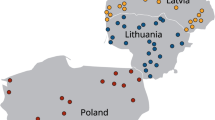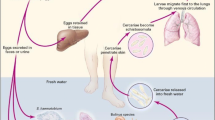Abstract
Adenylate kinases (ADKs) are one of the important enzymes regulating adenosine triphosphate (ATP) metabolism in Echinococcus granulosus sensu lato. The objective of the present study was to explore the molecular characteristics and immunological properties of E. granulosus sensu stricto (G1) adenylate kinase 1 (EgADK1) and adenylate kinase 8 (EgADK8). EgADK1 and EgADK8 were cloned and expressed, and the molecular characteristics of EgADK1 and EgADK8 were analyzed through different bioinformatics tools. Western blotting was used to examine the reactogenicity of recombinant adenylate kinase 1 (rEgADK1) and recombinant adenylate kinase 8 (rEgADK8) and to evaluate their diagnostic value. The expression profiles of EgADK1 and EgADK8 in 18-day-old strobilated worms and protoscoleces were analyzed by quantitative real-time PCR, and their distribution in 18-day-old strobilated worms, the germinal layer, and protoscoleces was determined by immunofluorescence localization. EgADK1 and EgADK8 were successfully cloned and expressed. Bioinformatics analysis predicted that EgADK1 and EgADK8 have multiple phosphorylation sites and B-cell epitopes. Compared with EgADK8, EgADK1 and other parasite ADKs have higher sequence similarity. In addition, both cystic echinococcosis (CE)–positive sheep sera and Cysticercus tenuicollis–infected goat sera could recognize rEgADK1 and rEgADK8. EgADK1 and EgADK8 were localized in protoscoleces, the germinal layer, and 18-day-old strobilated worms. EgADK1 and EgADK8 showed no significant difference in their transcription level in 18-day-old strobilated worms and protoscoleces, suggesting that EgADK1 and EgADK8 may play an important role in the growth and development of E. granulosus sensu lato. Since EgADK1 and EgADK8 can be recognized by other parasite-positive sera, they are not suitable as candidate antigens for the diagnosis of CE.





Similar content being viewed by others
Data availability
The datasets supporting the conclusions of this article are included within the article.
References
Bahia D, Andrade LF, Ludolf F, Mortara RA, Oliveira G (2006) Protein tyrosine kinases in Schistosoma mansoni. Mem Inst Oswaldo Cruz 101(Suppl 1):137–143. https://doi.org/10.1590/s0074-02762006000900022
Bouvier LA, Miranda MR, Canepa GE, Alves MJM, Pereira CA (2006) An expanded adenylate kinase gene family in the protozoan parasite Trypanosoma cruzi. Biochim Biophys Acta 1760(6):913–921. https://doi.org/10.1016/j.bbagen.2006.02.013
Bowles J, Blair D, McManus DP (1992) Genetic variants within the genus Echinococcus identified by mitochondrial DNA sequencing. Mol Biochem Parasitol 54(2):165–173. https://doi.org/10.1016/0166-6851(92)90109-w
Brehm K (2010) The role of evolutionarily conserved signalling systems in Echinococcus multilocularis development and host-parasite interaction. Med Microbiol Immunol 199(3):247–259. https://doi.org/10.1007/s00430-010-0154-1
Cheetham GM (2004) Novel protein kinases and molecular mechanisms of autoinhibition. Curr Opin Struct Biol 14(6):700–705. https://doi.org/10.1016/j.sbi.2004.10.011
Craig PS, McManus DP, Lightowlers MW, Chabalgoity JA, Garcia HH, Gavidia CM, Gilman RH, Gonzalez AE, Lorca M, Naquira C et al (2007) Prevention and control of cystic echinococcosis. Lancet Infect Dis 7(6):385–394. https://doi.org/10.1016/S1473-3099(07)70134-2
Dalton JP, Skelly P, Halton DW (2004) Role of the tegument and gut in nutrient uptake by parasitic platyhelminths. Can J Zool 82(2):211–232. https://doi.org/10.1139/z03-213
de Almeida MI, Romanello L, DeMarco R, Pereira HDM (2012) Structural and kinetic studies of Schistosoma mansoni adenylate kinases. Mol Biochem Parasitol 185(2):157–160. https://doi.org/10.1016/j.molbiopara.2012.07.003
Deplazes P, Rinaldi L, Rojas CAA, Torgerson PR, Jenkins EJ (2017) Global distribution of alveolar and cystic echinococcosis. Adv Parasitol 95:315–493. https://doi.org/10.1016/bs.apar.2016.11.001
Dissous C, Khayath N, Vicogne J, Capron M (2006) Growth factor receptors in helminth parasites: signalling and host–parasite relationships. FEBS Lett 580(12):2968–2975. https://doi.org/10.1016/j.febslet.2006.03.046
Dzeja P, Terzic A (2009) Adenylate kinase and AMP signaling networks: metabolic monitoring, signal communication and body energy sensing. Int J Mol Sci 10(4):1729–1772. https://doi.org/10.3390/ijms10041729
Gao Y, Zhou X, Wang H, Liu R, Ye Q, Zhao Q, Ming Z, Dong H (2017) Immunization with recombinant schistosome adenylate kinase 1 partially protects mice against Schistosoma japonicum infection. Parasitol Res 116(6):1665–1674. https://doi.org/10.1007/s00436-017-5441-y
Gao YR, Chen L, Li MC, Li YH, Lei L, Wu Q, Xu JH, Gao J, Li Y, Li L (2020) Role of adenylate kinase 1 in the integument development of Schistosoma japonicum schistosomula. Acta Trop 207:105467. https://doi.org/10.1016/j.actatropica.2020.105467
Golassa L, Abebe T, Hailu A (2011) Evaluation of crude hydatid cyst fluid antigens for the serological diagnosis of hydatidosis in cattle. J Helminthol 85(1):100–108. https://doi.org/10.1017/S0022149X10000349
Ionescu MI (2019) Adenylate kinase: a ubiquitous enzyme correlated with medical conditions. Protein J 38(2):120–133. https://doi.org/10.1007/s10930-019-09811-0
Jeyathilakan N, Basith SA, John L, Chandran NDJ, Raj GD, Churchill RR (2014) Evaluation of native 8 kDa antigen based three immunoassays for diagnosis of cystic echinococcosis in sheep. Small Ruminant Res 116(2–3):199–205. https://doi.org/10.1016/j.smallrumres.2013.10.012
Jones MK, Gobert GN, Zhang L, Sunderland P, McManus DP (2004) The cytoskeleton and motor proteins of human schistosomes and their roles in surface maintenance and host–parasite interactions. BioEssays 26(7):752–765. https://doi.org/10.1002/bies.20058
Khan A, El-Buni A, Ali M (2001) Fertility of the cysts of Echinococcus granulosus in domestic herbivores from Benghazi, Libya, and the reactivity of antigens produced from them. Ann Trop Med Parasitol 95(4):337–342. https://doi.org/10.1080/00034980120053258.
Kulkarni P, Shah N, Waghela B, Pathak C, Pappachan A (2019) Leishmania donovani adenylate kinase 2a prevents ATP-mediated cell cytolysis in macrophages. Parasitol Int 72:101929. https://doi.org/10.1016/j.parint.2019.101929
Kwon SB, Kim P, Woo HS, Kim TY, Kim JY, Lee HM, Jang YS, Eun-Min K, Tai-Soon Y, Baik LS (2018) Recombinant adenylate kinase 3 from liver fluke Clonorchis sinensis for histochemical analysis and serodiagnosis of clonorchiasis. Parasitology 145(12):1531–1539. https://doi.org/10.1017/S0031182018000434
Liang P, Zhang F, Chen W, Hu X, Huang Y, Li S, Ren M, He L, Li R, Li X (2013) Identification and biochemical characterization of adenylate kinase 1 from Clonorchis sinensis. Parasitol Res 112(4):1719–1727. https://doi.org/10.1007/s00436-013-3330-6
Livak KJ, Schmittgen TD (2001) Analysis of relative gene expression data using real-time quantitative PCR and the 2− ΔΔCT method. Methods 25(4):402–408. https://doi.org/10.1006/meth.2001.1262
Ma J, Rahlfs S, Jortzik E, Schirmer RH, Przyborski JM, Becker K (2012) Subcellular localization of adenylate kinases in Plasmodium falciparum. FEBS Lett 586(19):3037–3043. https://doi.org/10.1016/j.febslet.2012.07.013
McManus DP, Smyth JD (1979) Isoelectric focusing of some enzymes from Echinococcus granulosus (horse and sheep strains) and E. multilocularis. Trans R Soc Trop Med Hyg 73(3):259–265. https://doi.org/10.1016/0035-9203(79)90079-8
Noguera ZLP, Charypkhan D, Hartnack S, Torgerson PR, Rüegg SR (2022) The dual burden of animal and human zoonoses: a systematic review. PLoS Negl Trop Dis 16(10):e0010540. https://doi.org/10.1371/journal.pntd.0010540
Noma T (2005) Dynamics of nucleotide metabolism as a supporter of life phenomena. J Med Invest 52(3–4):127–136. https://doi.org/10.2152/jmi.52.127
Panayiotou C, Solaroli N, Karlsson A (2014) The many isoforms of human adenylate kinases. Int J Biochem Cell Biol 49:75–83. https://doi.org/10.1016/j.biocel.2014.01.014
Pontiggia F, Zen A, Micheletti C (2008) Small-and large-scale conformational changes of adenylate kinase: a molecular dynamics study of the subdomain motion and mechanics. Biophys J 95(12):5901–5912. https://doi.org/10.1529/biophysj.108.135467
Pradet A, Raymond P (1983) Adenine nucleotide ratios and adenylate energy charge in energy metabolism. Annu Rev Plant Physiol 34(1):199–224. https://doi.org/10.1146/annurev.pp.34.060183.001215
Qian MB, Abela Ridder B, Wu WP, Zhou XN (2017) Combating echinococcosis in China: strengthening the research and development. Infect Dis Poverty 6(1):161. https://doi.org/10.1186/s40249-017-0374-3
Recacha R, Talalaev A, DeLucas L, Chattopadhyay D (2000) Toxoplasma gondii adenosine kinase: expression, purification, characterization, crystallization and preliminary crystallographic analysis. Acta Crystallogr D Biol Crystallogr 56(Pt 1):76–78. https://doi.org/10.1107/s0907444999013840
Simpson KJ, Selfors LM, Bui J, Reynolds A, Leake D, Khvorova A, Brugge JS (2008) Identification of genes that regulate epithelial cell migration using an siRNA screening approach. Nat Cell Biol 10(9):1027–1038. https://doi.org/10.1038/ncb1762
Taku I, Hirai T, Makiuchi T, Shinzawa N, Iwanaga S, Annoura T, Nagamune K, Nozaki T, Saito-Nakano Y (2021) Rab5b-associated Arf1 GTPase regulates export of N-myristoylated adenylate kinase 2 from the endoplasmic reticulum in Plasmodium falciparum. Front Cell Infect Microbiol 10:610200. https://doi.org/10.3389/fcimb.2020.610200
Tamarozzi F, Nicoletti GJ, Neumayr A, Brunetti E (2014) Acceptance of standardized ultrasound classification, use of albendazole, and long-term follow-up in clinical management of cystic echinococcosis: a systematic review. Curr Opin Infect Dis 27(5):425–431. https://doi.org/10.1097/QCO.0000000000000093
Tanabe T, Yamada M, Noma T, Kajii T, Nakazawa A (1993) Tissue-specific and developmentally regulated expression of the genes encoding adenylate kinase isozymes. J Biochem 113(2):200–207. https://doi.org/10.1093/oxfordjournals.jbchem.a124026
Thompson RC (2017) Biology and systematics of Echinococcus. Adv Parasitol 95:65–109. https://doi.org/10.1016/bs.apar.2016.07.001
Villa H, Pérez-Pertejo Y, García-Estrada C, Reguera RM, Requena JM, Tekwani BL, Balaña-Fouce R, Ordóñez D (2003) Molecular and functional characterization of adenylate kinase 2 gene from Leishmania donovani. Eur J Biochem 270(21):4339–4347. https://doi.org/10.1046/j.1432-1033.2003.03826.x
Wen H, Vuitton L, Tuxun T, Li J, Vuitton DA, Zhang W, McManus DP (2019) Echinococcosis: advances in the 21st century. Clin Microbiol Rev 32:1–39. https://doi.org/10.1128/CMR.00075-18
Wu M, Yan M, Xu J, Liang Y, Gu X, Xie Y, Jing B, Lai W, Peng X, Yang G (2018) Expression, tissue localization and serodiagnostic potential of Echinococcus granulosus leucine aminopeptidase. Int J Mol Sci 19(4):1063. https://doi.org/10.3390/ijms19041063
Xiao S, Feng J, Yao M (1995) Effect of antihydatid drugs on carbohydrate metabolism of metacestode of Echinococcus granulosus. Chin Med J 108(9):682–688
Zhan J, Song H, Wang N, Guo C, Shen N, Hua R, Shi Y, Angel C, Gu X, Xie Y, Lai W, Peng X, Yang G (2020) Molecular and functional characterization of inhibitor of apoptosis proteins (IAP, BIRP) in Echinococcus granulosus. Front Microbiol 11:729. https://doi.org/10.3389/fmicb.2020.00729
Zutshi S, Kumar S, Sarode A, Roy S, Sarkar A, Saha B (2020) Leishmania major adenylate kinase immunization offers partial protection to a susceptible host. Parasite Immunol 42(2):e12688. https://doi.org/10.1111/pim.12688
Acknowledgements
The authors thank Ning Wang, Cheng Guo, Maodi Wu, Lang Xiong, and Nengxing Shen (Sichuan Agricultural University) for their constructive suggestions on the manuscript preparation. We would like to thank the native English–speaking scientists of Elixigen Company (Huntington Beach, CA) for editing our manuscript.
Funding
This research was funded by the National Natural Science Foundation of China (Grant No. 31672547) and the Key Technology R&D Program of Sichuan Province, China (No. 2022YFN0013).
Author information
Authors and Affiliations
Contributions
Guang-You Yang conceived and designed the study. Hong-Yu Song and Jia-Fei Zhan performed the experiments, analyzed the data, and wrote the manuscript. Rui-Qi Hua, Xue He, and Xiao-Di Du contributed to sample collection and performed the experiments. Jing Xu, Ran He, Xiao-Bin Gu, and Xue-Rong Peng contributed reagents/materials/analysis tools. Guang-You Yang and Yue Xie critically revised the manuscript. All authors read and approved the final version of the manuscript.
Corresponding author
Ethics declarations
Ethics approval
The animal study was reviewed and approved by the Animal Care and Use Committee of Sichuan Agricultural University (SYXK2019-187). All animal procedures used in this study were carried out in accordance with the Guide for the Care and Use of Laboratory Animals (National Research Council, Bethesda, MD, USA) and recommendations of the ARRIVE guidelines (https://www.nc3rs.org.uk/arrive-guidelines). All methods were carried out in accordance with relevant guidelines and regulations.
Consent for publication
Not applicable.
Conflict of interest
The authors declare no competing interests.
Additional information
Section Editor: Bruno Gottstein
Publisher's note
Springer Nature remains neutral with regard to jurisdictional claims in published maps and institutional affiliations.
Supplementary Information
Below is the link to the electronic supplementary material.

436_2023_7857_MOESM1_ESM.jpg
Supplementary file1 Fig. 1 Sequence alignment of ADK1 (a) and ADK8 (b) of E. granulosus s.s. (G1). GenBank accession numbers are shown in parentheses. (a) Eg: Echinococcus granulosus (CDS21649.1); Em: Echinococcus multilocularis (CDI97370.1); Ht: Hydatigera taeniaeformis (VDM30539.1); Hm: Hymenolepis microstoma (CDS32281.1); Mc: Mesocestoides corti (VDD80334.1); Ta: Taenia asiatica (VDK35971.1); Sm: Schistosoma mansoni (XP_018648199.1); Ss: Schistocephalus solidus (VDL93760.1); Fh: Fasciola hepatica (THD21832.1); Cs: Clonorchis sinensis (GAA27625.1). (b) Eg: Echinococcus granulosus (CDS20102.1); Em: Echinococcus multilocularis (CDI98446.); Ta: Taenia asiatica (VDK22632.1); Mc: Mesocestoides corti (VDD74805.1); Ss: Schistocephalus solidus (VDL91208.1); Hd: Hymenolepis diminuta (VUZ47486.1); Cs: Clonorchis sinensis (RJW60895.1); Sj: Schistosoma japonicum (TNN19731.1); Fh: Fasciola hepatica (THD23244.1); Hm: Hymenolepis microstoma (CDS28946.1). (JPG 5471 KB)
Rights and permissions
Springer Nature or its licensor (e.g. a society or other partner) holds exclusive rights to this article under a publishing agreement with the author(s) or other rightsholder(s); author self-archiving of the accepted manuscript version of this article is solely governed by the terms of such publishing agreement and applicable law.
About this article
Cite this article
Song, HY., Zhan, JF., Hua, RQ. et al. Molecular characterization and immunological properties of Echinococcus granulosus sensu stricto (G1) ADK1 and ADK8. Parasitol Res 122, 1557–1565 (2023). https://doi.org/10.1007/s00436-023-07857-9
Received:
Accepted:
Published:
Issue Date:
DOI: https://doi.org/10.1007/s00436-023-07857-9




